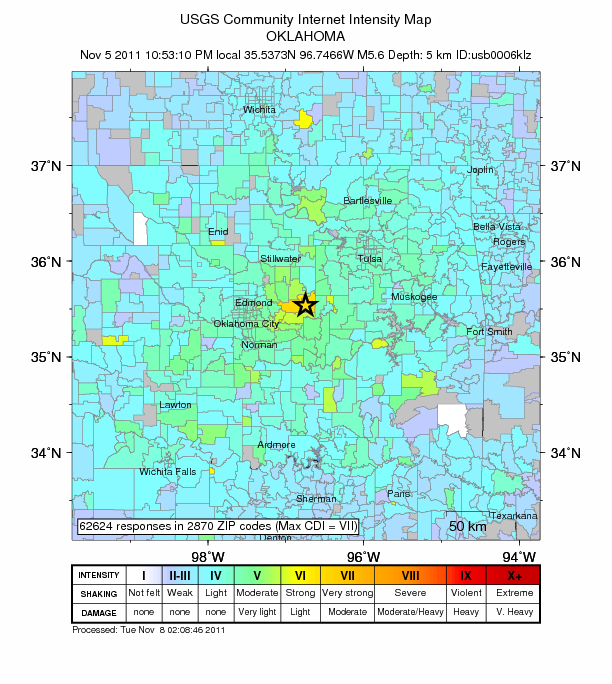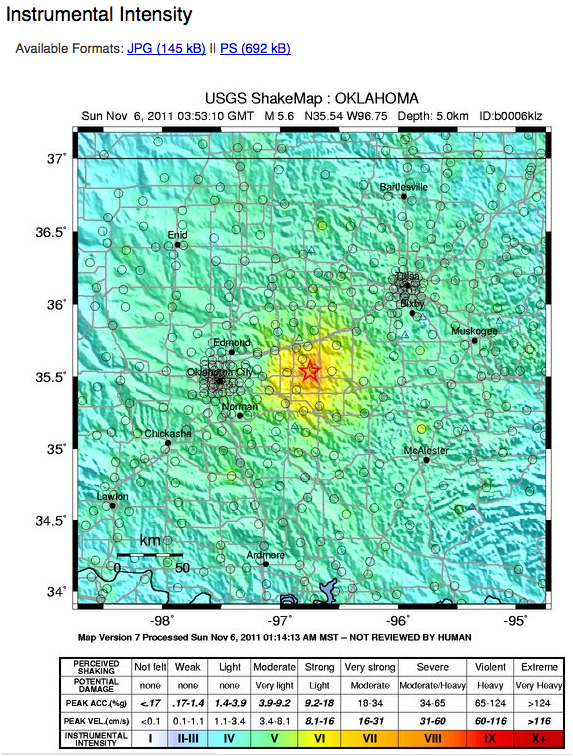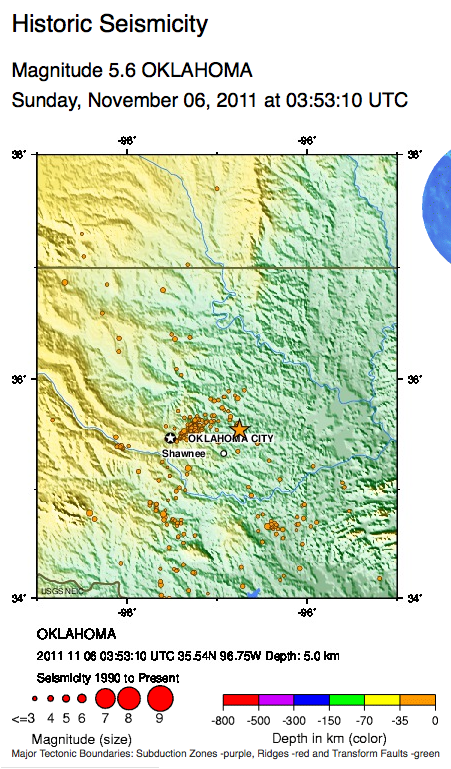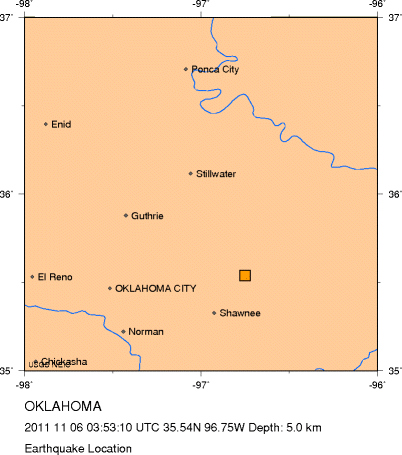- On the weekend of November 5, 2011 , a pair of unexpectedly large earthquakes occurred in a region about 50 km east of Oklahoma City, Oklahoma. Earthquakes are not unusual in Oklahoma but they are often too small to be felt.
Earthquake History in the area1
- magnitude 4.7; source depth 4 km; location: 35.553°N, 96.748°W; strike,dip,rake: 302°/69°/-3° (so this was a strike-slip event); 02:12 pm CDT 05 November 2011 (07:12 UTC, 05 November 2011)
- magnitude 5.6; source depth 5 km; location: 35.537°N, 96.747°W; strike,dip,rake: 326°/74°/-9° (so this was a strike-slip event); 10:53 pm CDT 05 November 2011 (03:53 UTC, 06 November 2011)
- from 1972-2008: 2-6 earthquakes per year; scattered broadly across east-central part of state
- 2008: EQ rate began to rise; with > 12 events in region east-northeast of Oklahoma City and southwest of Tulsa
- 2009: nearly 50 events; many big enough to be felt
- 2010: this activity continued
- 2011: the magnitude 4.7 and 5.6 events are the largest to hit Oklahoma in modern times
- the magnitude 4.7 is assumed to be a foreshock of the 5.6 event
- aftershocks will continue to last for weeks to months, which is "normal"
- USGS warns that there is a small possibility of a larger earthquake to follow but stresses that the recent increase in seismicity is not necessarily a sign that an even larger event is imminent
- the 5.6 quake was felt as far away as 500 km
- more than 60,000 people from 14 states reported their observations on the USGS "Did you feel it?" website.
 USGS did you feel it? |
 USGS shake map instrumental intensity |
 USGS historical seismicity |
|
 Area Cities Map |
 USGS Topographic Map |
 USGS PAGER impact page |
 USGS seismic hazard map |
Earthquake Location1
- no known active faults in the region but there are some ancient faults
- Wilzetta fault: one of several faults formed approx. 300 Mio years ago during intraplate deformation (Ancenstral Rocky Mountains mountain-building episode in the Pennsylvanian Epoch); may be location of a magnitude 4.1 event on 27 February 2010; but generally not clear if this fault is active
- Meers fault: south-central Oklahoma, about 100 km southwest of Oklahoma City; only fault is state with clear evidence of surface rupturing within last 3000 years (from paleoseismology; no historical records); two events occurred 1200-2900 years ago, the third one earlier
- given the overall state of the North American plate, it is believed that a magnitude 5.6 quake can happen anywhere in eastern North America at irregular intervals
- due to the different geology (solid bedrock instead of loose sediments) a magnitude 4.0 quake in the eastern U.S. can be felt much farther away (typically to 100 km) than a similar quake in California. Such a quake in frequently causes damage near the source. A magnitude 5.5 quake in the east can be felt 500 km away and sometimes causes damage as far away as 40 km.
Other Info2
- last most powerful event recorded in Oklahoma: magnitude 5.5 event in 1952 near El Reno
- maximum intensity VIII felt near town of Prague
- no deaths reported; 2 people suffering minor injury
- early damage reports include buckling of U.S. Route 62 in 3 locations
- major damage to several homes damaged
- numerous reports of broken windows and minor masonry damage
- a turret collapsed and two others were damaged at Benedict Hall at St Gregory's University in Shawnee
- a few residents reported a noise sounding like thunder
Other Info on possible Human Impact from the News3
- no link between these quakes and the magnitude 5.8 quake in Virginia in August
- no indication that Earth has been shaking more than in the past
- some speculation that events may be related to local oil and gas exploration (by a private person).
NB: this would be a case of induced seismicity - A study by a researcher at the Oklahoma Geological Survey at the University of Oklahoma in Norman was published in August relating a swarm of events in January in an area of south-central Oklahoma with active hydrolic fracturing (fracking) which is a form of natural gas and oil drilling using pressurized water and other materials. 50 small earthquakes, with magnitude between 1.0 and 2.8, had occurred within about two miles of Eola Field, a fraicking operation in southern Garvin County.
- The interviewed scientist from the USGS in Golden, CO (who was not the author) said that the study also examined EQs in a different part of the state, and that despite concern in Oklahoma, Arkansas, Texas and Pennsylvania, there have been no recent studies he knows of showing that fracking causes earthquakes. He did note that other cases of induced seismicity were related to injection wells such as those used by the U.S. military near Denver that were linked to induced seismicity in the 1960s. The scientist was cited as saying that he knew of no recent studies showing that fracking caused earthquakes.
NB: this is no entirely correct, see below.
A Clear Case of Induced Seismicity by Hydro Fracking4
- The Deep Heating Mining Project in Basel, Switzerland induced seismicity from hydro fracking. In a test well, they pumped water into hot rock in a 4-5-km-deep well at high pressure in order to fracture rocks for future geothermal energy generation. Independent studies showed that seismicity between December 2006 and March 2007 was clearly related to pumping water and culminated with a magnitude 3.4 quake that was clearly felt in the region. A total of 13,500 potential events were recorded. The largest 200 events had magnitudes greater than 0.7 and occurred within 1 km of the well. 2700 damage claims from homeowners followed the magnitude 3.4 quake, and injurers estimated the total of damages at 7-9 Mio CHF ($6.5-8.3 Mio). The project was canceled subsequently and the U.S. reacted with new regulations on deep geothermal energy projects.
- an interesting question now arises: what if oil exploration really did induce the Oklahoma seismicity? Would the oil industry get away with causing earthquakes and damage homes? Would the population accept this risk in exchange of being able to carrying out an unsustainable and climate-damaging lifestyle a little longer?
References
2 info on Wikipedia website; click here.
3 info from LA Times; click here.
4 info on Wikipedia website; click here. For the Basel case and other cases of induced seismicity see also new book chapter 5.